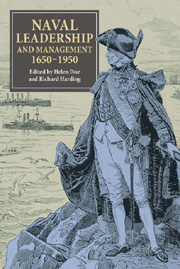Book contents
- Frontmatter
- Contents
- List of Tables
- List of Editors and Contributors
- Acknowledgements
- List of Abbreviations
- Michael Duffy: An Appreciation
- Introduction
- Leadership: The Place of the Hero
- Leadership and Organisational Frictions: Contested Territories
- Management Capability and the Exercise of Naval Power
- The Evolution of Management Training in the Royal Navy, 1800–1950
- 8 New Kinds of Discipline: The Royal Navy in the Second Half of the Nineteenth Century
- 9 Towards a Hierarchy of Management: The Victorian and Edwardian Navy, 1860–1918
- 10 Leadership Training for Midshipmen, c.1919–1939
- Select Bibliography
- Index
9 - Towards a Hierarchy of Management: The Victorian and Edwardian Navy, 1860–1918
from The Evolution of Management Training in the Royal Navy, 1800–1950
Published online by Cambridge University Press: 05 February 2013
- Frontmatter
- Contents
- List of Tables
- List of Editors and Contributors
- Acknowledgements
- List of Abbreviations
- Michael Duffy: An Appreciation
- Introduction
- Leadership: The Place of the Hero
- Leadership and Organisational Frictions: Contested Territories
- Management Capability and the Exercise of Naval Power
- The Evolution of Management Training in the Royal Navy, 1800–1950
- 8 New Kinds of Discipline: The Royal Navy in the Second Half of the Nineteenth Century
- 9 Towards a Hierarchy of Management: The Victorian and Edwardian Navy, 1860–1918
- 10 Leadership Training for Midshipmen, c.1919–1939
- Select Bibliography
- Index
Summary
The years from 1860 to 1918 saw the Royal Navy move from marked decline to rapid expansion; from 834 lieutenants in 1883 to 2,227 in 1914. It was a navy which had come from the Old Navy of ad hoc, dispersed sailing ships to the battlefleet New Navy, ready (and enthusiastic) to take on any nation that threatened its hegemony. Lord Chatfield declared, ‘It was a transformation, not only of material development of the Service, but of the mentality of the whole personnel’. It is this transitional change, involving as it did an incremental change in management that is the subject of this chapter. The sailing navy became the transitional steam/sail navy and the transitional navy became the steam turbine new navy. For convenience, the term Old Navy is used for the years from about 1860 to 1885, Transitional Navy from about 1885 to 1895 and New Navy from about 1895 to 1914. This study is an analysis of the evidence of serving officers, their memoirs, biographies and autobiographies, and the secondary literature that has accompanied it.
Three brief case studies, using narratives over three generations in different periods are used to give a taste of contemporary shipboard life and throw new light upon the changes in leadership and management. By virtue of what the writers chose to record of their priorities, values, beliefs etc., they are illustrative of the changes. It is not intended to prove how, why or when the changes took place.
- Type
- Chapter
- Information
- Naval Leadership and Management, 1650–1950 , pp. 157 - 172Publisher: Boydell & BrewerPrint publication year: 2012



